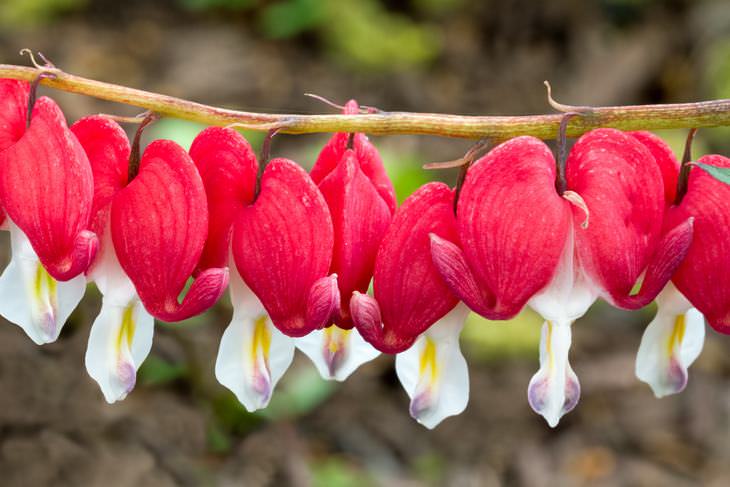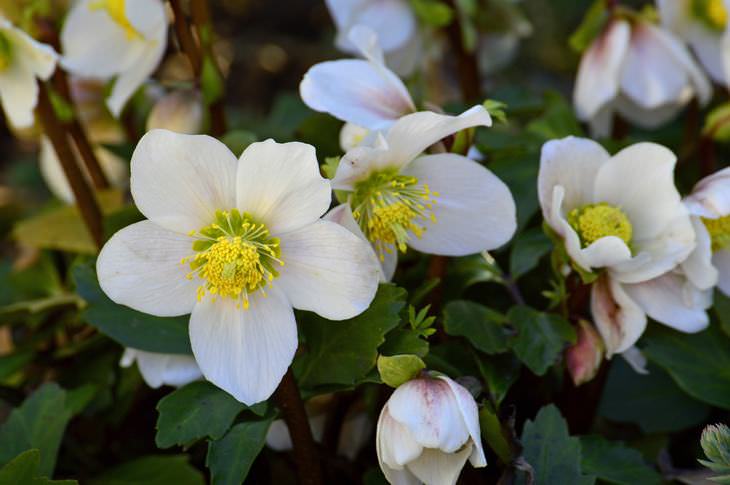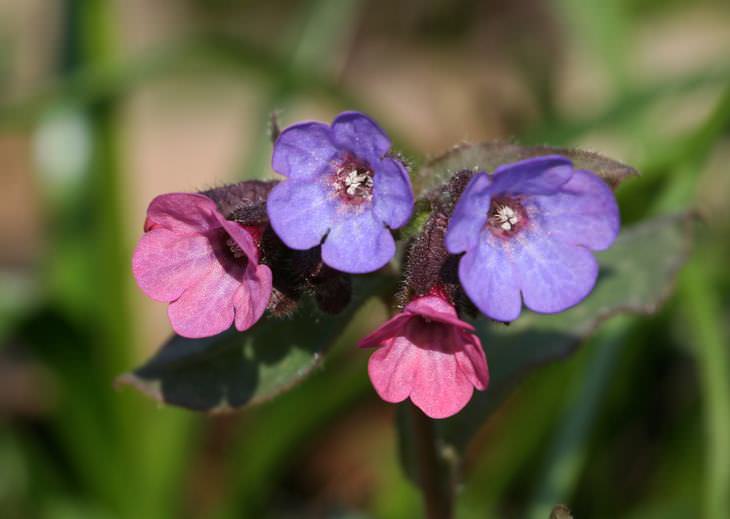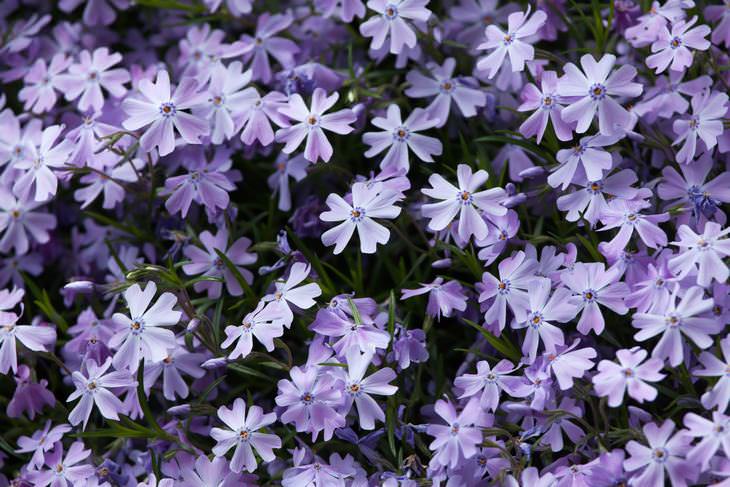

While their name may throw you off, these flowers are quite pretty - they look like little cherry charms dangling down the length of each branch with attractive leaves. While this flower is a welcome sight in the spring, as the days lengthen and the temperature warms, the bleeding heart starts to turn yellow and forlorn and may even disappear entirely throughout the summer months. A solution to this - plant it near later emerging plants to fill the space as this flower fades. You can opt for flowers like Hosta and Astilbe or even ferns - which will make a great companion for bleeding hearts. Here are a few tips to bear in mind:
Growing conditions: Keep in moist, rich soil that is well draining. Its roots can rot in soil that remains wet for a long time.
Exposure: Partial shade is ideal.
Hardiness: USDA Hardiness Zones 2 - 9

This spring flower is small, with white petals that can really brighten a shady or woodland garden. Once the flowers disappear, the blue-green leaves will provide a nice foil for summer flowers. Also, bloodroot is not invasive and isn't an aggressive plant. It can take several years for your bloodroot plants to become established and start to spread, but they don't live too long. It comes in two varieties, single, and double-flowered. While the doubles tend to be more expensive, they are stunning.
Growing Conditions: Usually, this flower grows in woodland spaces, but with lots of organic matter added to the soil, and leaf mold, it will give the plant the moisture it needs to flourish.
Exposure: While Bloodroot can handle full sun in the spring, during summer it will need a shady cover.
Hardiness: USDA Hardiness Zones 3 - 9

While it may come as a surprise, the heart-shaped leaves of this flower have been getting more attention than it's brilliant blue flowers. Regardless of whether you grow it for its flowers or foliage, it's an easy plant to care for. However, as it emerges early spring, its leaves can get a bit tattered in summer. Still, all that you'd need to do is cut them back and leaves will fill in. It's a slow growing plant, but eventually, it will form a nice size clump. As this flower tends to be short-lived, to keep it around longer, divide the plants every three years or so to reinvigorate them.
Growing Conditions: Brunner can be planted in your shady garden or under the shade of nearby taller plants. The blue flowers bloom early spring.
Exposure: As with many spring bloomers, Brunnera can handle full sun in the spring, but will do best in partial shade.
Hardiness: USDA Hardiness Zones 3 - 9

The Hellebores are slow growing perennials that can be quite pricey to purchase. And if you're not fussy about the color, you can also find seed packets of mixed blends. While you'll have to wait a couple of years for the seed grown hellebores to bloom, once they do, they will be around for decades and they will spread slowly. These flowers come in shades of pink, purple, burgundy and cream. Most varieties come with nodding flowers, making them look somewhat sleepy and comforting in the garden. These flowers are basically shade garden plants and they look great when paired with ferns and shiny-leaved plants like ginger.
Growing Conditions: All these flowers need is a shady spot to be happy. They can't tolerate excessively dry and excessively wet soils.
Exposure: Partial shade to shade is ideal. If planted in a sunny spot, the leaves will dry and turn crispy when the temperature heats up.
Hardiness: USDA Hardiness Zones 5 - 9

This plant has beautiful flowers and flashy foliage - its leaves are dotted, speckled and splashed with white and silver. However, they tend to fade away come summer. The flowers are clear white while in bloom. Some of the flowers also start off pink and turn blue after they are pollinated.
Growing Conditions: Lungwort prefers the shade and rich soil. SO give it plenty of compost when planted and side dress it each year to keep the soil rich.
Exposure: Partial shade to shade. Lungwort gives up quickly in hot sun.
Hardiness: USDA Hardiness Zones 4 - 8

Ever notice that carpet of flowers that seem to spill across spots on lawns or over rock walls? This flower is usually planted in large masses which makes a big splash that literally turns heads. It comes in pastel shades of pink and lavender and also, bolder hot pinks and clear white. While the flowers don't last long, they put on quite a show when in full bloom.
Growing Conditions: This flower can handle poor growing conditions so long as it gets plenty of water. Richer soil will produce lusher plants.
Exposure: Full sun to partial shade. This plant tends to flower better in full sun, while keeping its leaves fresh in a little afternoon shade.
Hardiness: USDA Hardiness Zones 3 - 9. It will probably need some protection in Zones 3 - 4.

While this may not be a flashy flower, it's no wallflower either. Its flowers are tiny, but there are plenty of them and they're held high above the glossy, leathery leaves by burgundy stems. While it blooms in early spring, the leaves look good throughout the season, and in the fall they turn a nice bronze-red. Its flowers are pink, but cultivars have been bred with white, red and violet blooms. In case you're wondering why its called pig squeak it's because of the sound it makes when you rub its leaves between your fingers.
Growing Conditions: Rich, moist soil with lots of compost.
Exposure: Full sun to partial shade. If you plant it in full sun, make sure your soil can hold moisture.
Hardiness: USDA Hardiness Zones 3 - 8

These flowers come in quite a number of varieties. The common primrose - Primula vulgaris, the cowslips - primula veris, and that which holds the flower clusters on tall, straight stems - Primula acaulis. While they all vary a bit in shape and size, they look best in large clumps, especially spreading out under trees.
Growing Conditions: Most prefer rich, moist soil and cool weather.
Exposure: Full sun to partial shade.
Hardiness: USDA Hardiness Zones 3 - 9. Primroses need a winter chill to bloom their best.